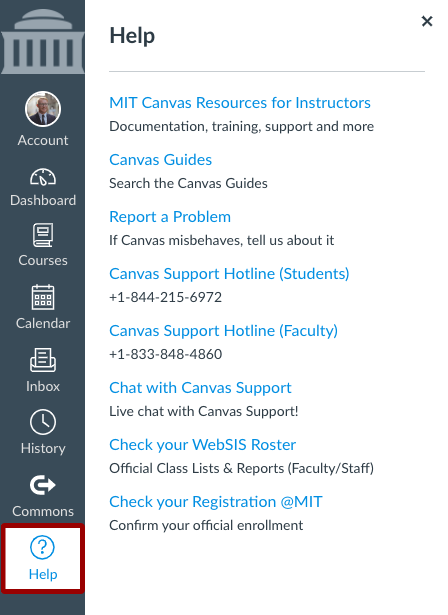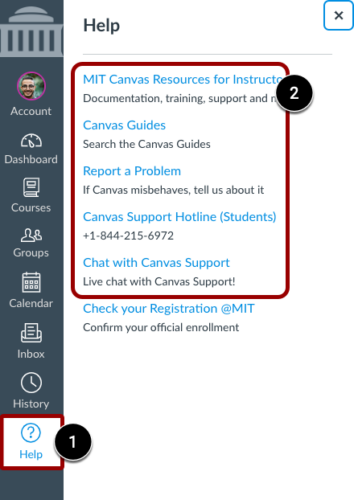SKIP AHEAD TO
At a Glance
Have a question? Explore a list of frequently asked questions about non-standard Canvas sites at MIT Sloan below.
SKIP AHEAD TO
Have a question? Explore a list of frequently asked questions about non-standard Canvas sites at MIT Sloan below.
Review the following requirements to ensure you qualify for a non-standard Canvas BEFORE submitting your request.
Non-standard Canvas sites:
Your request must be submitted at least 30 days BEFORE the proposed start date to allow us time to review it.
To request a Canvas site for a non-standard course, submit this form.
Non-standard Canvas sites are self-supported by you and your teaching team.
Instructure provides 24/7 support to faculty, staff, and teaching assistants by phone or chat. You can also search the Canvas Guides for step-by-step instructions.
If you have questions about using Canvas and its features, you can get help by using the Help menu in the Global Navigation Menu:

Canvas offers 24/7 support for students via live chat and phone. Your students can get help with Canvas by using the Help menu in the Global Navigation Menu (on the left). Canvas also has a comprehensive knowledgebase with step-by-step instructions for students.

If your request is approved, you will be automatically added to your non-standard Canvas site as a Primary Course Admin.
Any enrollments for other members of your teaching team (e.g., Teachers, Course Admins, Graders, Mentors) are self-managed by you via the Membership Tool.
No, all student enrollments in non-standard Canvas sites are self-managed by you and your teaching team via the Membership Tool.
Tip: You can copy and paste MIT IDs in bulk in the Membership Tool. We recommend using MIT IDs instead of MIT email addresses.
You and your teaching team need to sponsor guest Kerberos accounts for any non-MIT people in your Canvas site.
For more information, refer to How to Add a Teacher-Like Guest to a Canvas Course.
To learn how to add or remove an enrollment, change the role of an enrollment, or change the section of an enrollment, refer to How to Use the Membership Tool in Canvas.
Your courses sessions are NOT automatically recorded. If you want your course sessions to be livestreamed or recorded using Panopto, submit a support request.
Once your recording request is processed, you can share your upcoming livestream or recording in Canvas.
To learn how to change the name of your course in Canvas, refer to How to Change Your Course Name in Canvas.
You can copy course content such as assignments, modules, pages, and discussions from previous Canvas courses into your non-standard Canvas site. Note: You only have access to copy content from courses in which you are enrolled as a Teacher or Course Admin.
For step-by-step instructions, refer to How do I copy content from another Canvas course using the Course Import tool?
You can add a file to your course via the Files tool. You can also import files using the Course Import Tool in Course Settings.
Once you have added or imported files to your course, you can edit their permissions, including setting the state of the file (published or unpublished), restrict file access to students who have the link, or schedule availability dates for the files.
For step-by-step instructions, refer to:
If your students will be working together on group projects and assignments, you can create groups, assign each student to a group, and then create a group assignment to collect their work.
With group assignments, one submission will count for the entire group. Learn more about evaluating group work.
For step-by-step instructions, refer to:
Note: Students should be assigned to groups BEFORE group assignments are published. Grades and submissions may be affected for students who were not in a group at the time of assignment submission but who were later added to a group or students who were removed from a group.
You can create assignments on the Assignments page. You can create an assignment shell, which is a placeholder for an assignment within an assignment group, or you can create an entire assignment with all the assignment details at the same time. For step-by-step instructions, refer to:
Study.Net or Harvard Business Publishing (HBP) content cannot be used in non-standard Canvas sites.
Modules are like folders that can contain assignments, discussions, quizzes, content pages, files, and links all in one place. Modules are typically used to organize course content by class session, week, units, or some other organizational structure.
For step-by-step instructions, refer to:
You can view your course the same way that your students view it using the Student View tool. It allows you to:
For step-by-step instructions, refer to How do I view a course as a test student using Student View?
You can publish your course in the Course Home Page sidebar. Note: You must publish a course before students can access it. Students cannot see unpublished courses and content.
For step-by-step instructions, refer to How do I publish a course?
No, your non-standard Canvas site and its content cannot be made available to the public.
You can create an announcement to share important information with all students within your non-standard Canvas site and/or with students in specific sections of your Canvas site.
For step-by-step instructions, refer to How do I add an announcement in a course?
The SpeedGrader makes it easy to evaluate individual student assignments and group assignments quickly.
For step-by-step instructions, refer to:
By default, your non-standard Canvas site will be available until the course end date that was specified on the Non-Standard Canvas Sites Request Form. After this date, your course will close and become “read-only,” which means:
You can, however, extend the end date of your Canvas site until the last day of the course.
If your course will be running in a subsequent term, you’ll need to submit the Non-Standard Canvas Site Request Form again.